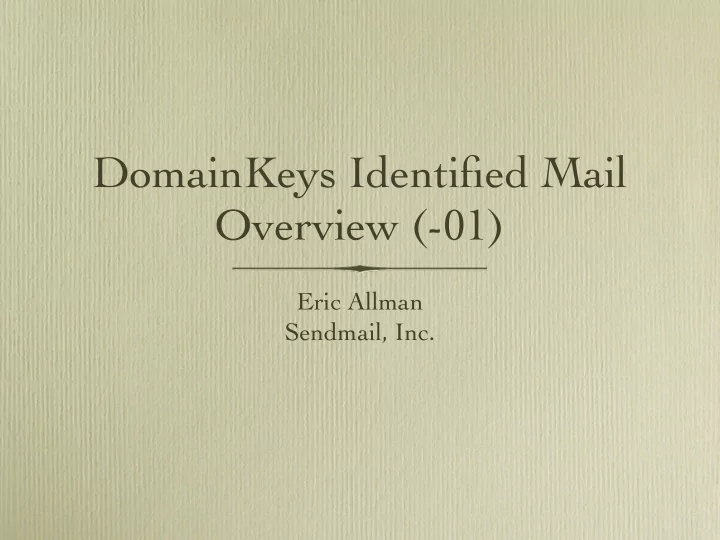

DomainKeys Identified Mail Overview (-01) Eric Allman Sendmail, Inc.
Overview of DKIM • Cryptography-based protocol, signs selected header fields and message body • Intended to: ▶ Enable reliable domain name based reputation lookups ▶ Allow good senders to provide evidence that they did send a particular message ▶ Dramatically increase the difficulty of forgers masquerading as those good senders (requires Sender Signing Policy) • Not an anti-spam technology by itself 2
Model (Simple) MUA MUA SMTP AUTH or TLS MS Submit MTA/ Intermed MTA/ MTA V eri fi er Signer 3
Model (with Edges) MUA MUA MS Submit MTA/ Intermed MTA/ Edge Edge MTA V eri fi er Signer MTA MTA 4
Model (Resigning) MUA MUA MS Submit MTA/ MLM/ MTA/ Re - Signer V eri fi er Signer 5
DKIM Design Goals • Low-cost (avoid large PKI, new Internet services) • No trusted third parties (key escrow, CA, etc.) required • No client User Agent upgrades required • Minimal changes for (naïve) end users • Validate message itself (not just path) • Allow sender delegation (e.g., outsourcing) • Extensible (key service, hash, public key) • Structure usable for per-user signing 6
DKIM Technology • Signature transmitted in DKIM-Signature header field ▶ DKIM-Signature is self-signed ▶ Signature includes the signing identity (not inherently tied to From:, Sender:, or even header) • Initially, public key stored in DNS (new RR type, fall back to TXT) in _domainkey subdomain • Namespace divided using selectors, allowing multiple keys for aging, delegation, etc. 7
DKIM-Signature Header • Example: DKIM-Signature: a=rsa-sha1; q=dns; d=example.com; i=user@eng.example.com; s=jun2005.eng; c=relaxed/simple; t=1117574938; x=1118006938; h=from:to:subject:date; b=dzdVyOfAKCdLXdJOc9G2q8LoXSlEniSb av+yuU4zGeeruD00lszZVoG4ZHRNiYzR • DNS query will be made to: jun2005.eng._domainkey.example.com 8
Ways to Use DKIM • Lets recievers reliably apply domain-based policies • Use signing identity for reputation lookups ▶ Signers who forge or spam will garner bad reputation ▶ Unsigned messages treated as “unknown reputation” • Reject (or warn) unsigned/improperly signed messages based on Sender Signing Policy ▶ Needed to deal with domain name spoofing/phishing • Mark authenticated senders to end users ▶ Has to correlate to what end user sees displayed ▶ Best done in MUA, but can be done by server • Display signing identity to end users ▶ Requires MUA support (probably) 9
dkim-base Changes Since -00 • Canonicalization ▶ nowsp eliminated in favor of relaxed ○ relaxed bodies keep CRLF; reduce all wsp to single space ▶ Split selection of header & body canonicalization ○ c=relaxed/simple • Added some IANA considerations • Grammar, spelling, clarifications, cleanup 10
DomainKeys Identified Mail Sender Signing Policy Eric Allman Sendmail, Inc.
Sender Signing Policy Rationale • Domain owners want to be able to control the use of their domain name • Signing alone is not sufficient to achieve this if unsigned messages are deemed to be legitimate by recipients 12
Sender Signing Policy • Primary content in today’s (-01) version: “o=” tag (outbound mail policy) ▶ “~” — domain doesn’t sign all messages (neutral) ▶ “–” — domain signs all messages; 3rd party signatures (3PS) should be accepted (strong) ▶ “!” — domain signs all messages; no 3PS (exclusive) ▶ “.” — domain never sends mail (never) ▶ “^” — do per-user policy lookup (user) ▶ “?” — not all signed, no 3PS (weak) (not in -01) • Does not need to be looked up if “From:” identity matches signing identity 13
Mailing Lists • Lists that do not break signatures ▶ No special requirements (“naive forwarding”) • Lists that break signatures ▶ Should probably re-sign for the list itself ▶ Should run spam and virus checks before retransmit ▶ Should verify incoming signatures, possibly reject on failure ▶ Not compatible with NO3PS policies • Note: multiple signatures not defined in spec 14
dkim-ssp Changes Since -00 • Document restructuring • Added section on third party signatures and mailing lists • Technical content unchanged 15
Recommend
More recommend